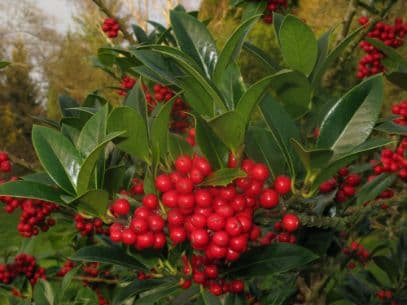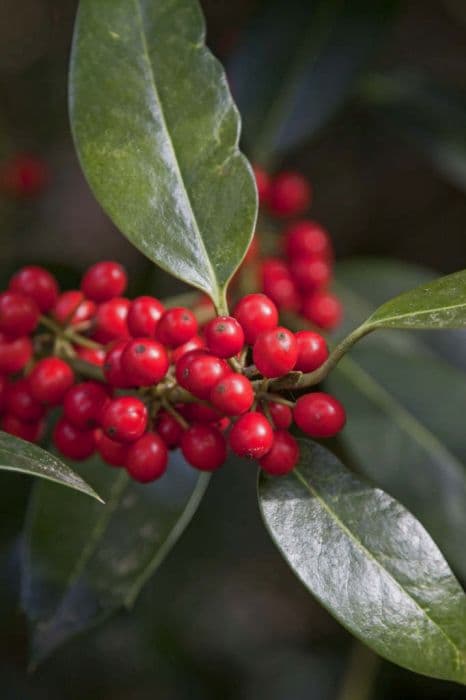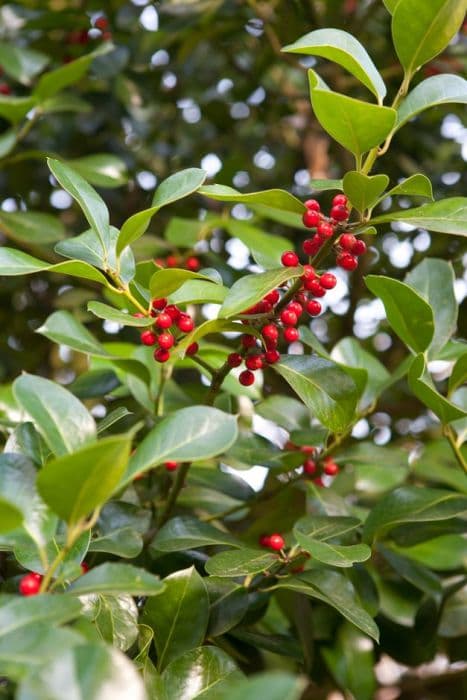English Holly Ilex aquifolium 'Alaska' (f)

ABOUT
The 'Alaska' variety of English holly is a female cultivar known for its ornamental appeal. This plant is distinguished by its glossy, dark green leaves which are generally shaped with a series of spiny points along the margins, giving them a prickly appearance. The foliage of English holly is evergreen, which means that the plant maintains its color and leaves throughout the year, regardless of the season. Flowers of this cultivar are small and white, generally present on the plant in late spring. As 'Alaska' is a female cultivar, it's capable of producing berries, but it requires a male pollinator nearby. Should pollination occur, the plant will produce its characteristic red berries, which are highly ornamental and a food source for birds during winter. These berries are small and spherical, providing a striking contrast to the dense, deep green foliage. The overall appearance of English holly 'Alaska' is dense and lush, making it a popular choice for gardeners who wish to create hedges or simply want an attractive stand-alone specimen that provides year-round interest. The combination of its vibrant leaves, white flowers, and red berries creates a festive look, often associated with the holiday season.
About this plant
 Names
NamesFamily
Aquifoliaceae
Synonyms
English Holly, European Holly, Christmas Holly
Common names
Ilex aquifolium.
 Toxicity
ToxicityTo humans
The plant commonly known as English Holly is toxic to humans. Ingesting any part of the plant, particularly the berries, can lead to symptoms such as nausea, vomiting, diarrhea, and abdominal pain. In severe cases, it may result in drowsiness, dehydration, and electrolyte imbalances. Children are especially susceptible to holly berry poisoning due to their smaller body size and the attractive nature of the red berries.
To pets
English Holly is also toxic to pets. Consumption of any part of the plant, especially the berries, can cause similar symptoms in animals as in humans. Pets might experience vomiting, diarrhea, decreased appetite, and excessive drooling. Severe poisoning can lead to lethargy, dehydration, and more serious gastrointestinal upset. Pet owners should prevent their animals from eating English Holly.
 Characteristics
CharacteristicsLife cycle
Perennials
Foliage type
Evergreen
Color of leaves
Green
Flower color
White
Height
6-10 feet (1.8-3 meters)
Spread
4-6 feet (1.2-1.8 meters)
Plant type
Shrub
Hardiness zones
5-9
Native area
Europe
Benefits
 General Benefits
General Benefits- Ornamental Value: Ilex aquifolium 'Alaska' provides year-round visual interest with its bright red berries and glossy green leaves with a distinctive spiky edge. It is widely used for Christmas decorations.
- Wildlife Attraction: The berries of the holly plant are a valuable food source for birds during the autumn and winter months when other food is scarce.
- Drought Resistant: Once established, it is relatively drought tolerant, making it a good choice for gardens in areas with lower rainfall.
- Hedging and Privacy: Because of its dense growth, it can be used effectively for hedging, providing both privacy and wind protection in gardens and landscapes.
- Shade Tolerance: Ilex aquifolium 'Alaska' can grow in areas with partial shade, making it versatile for planting in various garden locations.
- Easy Maintenance: The plant is generally low-maintenance, requiring minimal care other than occasional pruning to maintain its shape.
- Disease and Pest Resistance: It is known to have good resistance to many common pests and diseases, which makes it a robust choice for gardeners.
- Soil Adaptability: Holly 'Alaska' is adaptable to a range of soil types, although it prefers well-drained, moderately acidic to neutral soils.
- Long Lifespan: With proper care, this plant can live and thrive for many years, providing long-term benefits to the garden.
 Medical Properties
Medical Properties- This plant is not used for medical purposes.
 Air-purifying Qualities
Air-purifying QualitiesThis plant is not specifically known for air purifying qualities.
 Other Uses
Other Uses- Privacy Screening: Due to its dense growth, the common holly is often planted as a natural privacy screen in gardens and yards.
- Bird Protection: The spiky leaves of the common holly provide a safe haven for birds to nest and shelter from predators.
- Topiary: The common holly's ability to withstand frequent pruning makes it ideal for creating topiaries and other shaped hedges.
- Ink Production: Historically, the common holly's bark and berries have been used to make black dye, which could be used for ink.
- Winter Garden Interest: With its bright red berries and evergreen leaves, the common holly is used to add color and interest to gardens in the dull winter months.
- Craft Material: The wood of the common holly is fine-grained and is sometimes used in marquetry and inlay work.
- Cattle Feed: In some areas, the leaves of the common holly, after being crushed to soften the spines, have been used as emergency fodder for cattle.
- Leather Tanning: The tannins present in the bark of the common holly can be used in the tanning of leather.
- Traditional Carving: The white wood of common holly is valued for traditional carving crafts due to its fine grain and workability.
- Festive Decoration: Beyond Christmas, sprigs of common holly are often used in wreaths and garlands for various festivals and events.
Interesting Facts
 Feng Shui
Feng ShuiThe English Holly is not used in Feng Shui practice.
 Zodiac Sign Compitability
Zodiac Sign CompitabilityThe English Holly is not used in astrology practice.
 Plant Symbolism
Plant Symbolism- Protection: "Alaska" Holly, commonly referred to as Holly, has often been used to ward off negative energy and is believed to protect against evil spirits.
- Endurance: The Holly's evergreen nature exemplifies the ability to endure through challenging conditions, symbolizing resilience and perseverance.
- Good Fortune: With its association to the holiday season, Holly is considered a plant that brings good luck and prosperity.
- Fertility: Holly's robust growth has been linked with fertility and life, making it a symbol of vitality.
- Hope: The bright berries and evergreen leaves of Holly represent hope and the promise of renewal, even in the depths of winter.
 Water
WaterThe English Holly 'Alaska' should be watered thoroughly, allowing the top inch of soil to dry out between waterings. This typically means watering every 7 to 10 days, depending on climate conditions and the plant's environment. Use room temperature water, and apply it directly to the soil, avoiding wetting the foliage. An established plant may need around 1 to 1.5 gallons of water each time, making sure the water penetrates deeply to encourage robust root growth. Adjust the amount and frequency during the hotter seasons or drought periods to maintain consistent soil moisture.
 Light
LightEnglish Holly 'Alaska' thrives best in full sun to partial shade. The ideal spot is one where the plant receives at least 4 to 6 hours of direct sunlight daily, supplemented with partial shade, particularly in the heat of the afternoon. Avoid deep shade locations, as too little light can result in fewer berries and a less dense growth habit.
 Temperature
TemperatureEnglish Holly 'Alaska' can tolerate a range of temperatures but grows best in conditions between 35°F and 80°F. It can survive temporary dips down to about 0°F but sustained cold below this temperature can cause damage to the plant. English Holly is hardy and well adapted to cooler climates and should not be exposed to extended periods over 90°F, as excessive heat can stress the plant.
 Pruning
PruningPrune English Holly 'Alaska' to maintain its shape and encourage bushier growth. The best time for pruning is in the winter or early spring before new growth begins. Remove any dead, diseased, or damaged branches, and trim back any overgrown areas to promote a more appealing form. Pruning can be done annually or as needed to keep the plant looking tidy.
 Cleaning
CleaningAs needed
 Soil
SoilThe best soil mix for English Holly 'Alaska' should be well-draining and rich in organic matter with a slightly acidic to neutral pH of 5.5 to 7. You can create a suitable mix using one part garden soil, one part peat moss or compost, and one part perlite or coarse sand to improve drainage.
 Repotting
RepottingEnglish Holly 'Alaska' should be repotted every 2 to 3 years to prevent the plant from becoming root-bound and to replenish the soil nutrients. Choose a larger pot to accommodate growth every time you repot.
 Humidity & Misting
Humidity & MistingEnglish Holly 'Alaska' prefers moderate humidity levels but is quite adaptable and can tolerate the dryer air indoors without special humidity requirements.
 Suitable locations
Suitable locationsIndoor
Place in bright indirect light, keep soil moist.
Outdoor
Plant in well-drained soil, partial to full sun.
Hardiness zone
5-9 USDA
 Life cycle
Life cycleIlex aquifolium 'Alaska', commonly known as English Holly 'Alaska', begins its life cycle when the female flowers are pollinated, typically by bees attracted to their white blossoms, usually in the late spring. After pollination, the flowers develop into bright red berries, which mature in autumn and can persist through the winter. Meanwhile, the plant grows glossy, spiny, evergreen leaves that remain year-round. English Holly 'Alaska' can eventually grow into a small to medium-sized tree if conditions permit, reaching maturity in several years. As it matures, it will produce more flowers and berries each season, with the berries being a food source for birds, which in turn aids in seed dispersal. In its mature stage, this holly requires minimal maintenance, aside from occasional pruning to shape the plant or to keep it at a desired size, and it can live for many decades, with some hollies living for hundreds of years.
 Propogation
PropogationPropogation time
Early Spring
Propogation: Ilex aquifolium 'Alaska', commonly known as the English Holly, can be propagated primarily by seed or cuttings. However, the most popular method for this cultivar is to use semi-hardwood cuttings. To propagate English Holly 'Alaska' via cuttings, gardeners should take cuttings from new growth in late summer. It's crucial to select healthy, disease-free branches that have matured slightly but are not fully hardened. Cuttings should be about 6 to 8 inches long (15 to 20 centimeters), and the leaves on the lower half should be removed. The cut end of the cutting should then be dipped in rooting hormone to facilitate root development. Afterward, the cuttings are planted in a well-draining potting mix and kept moist until they root, which typically can take several weeks to a few months depending on environmental conditions.









